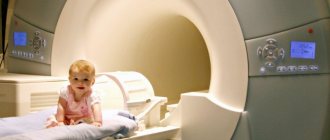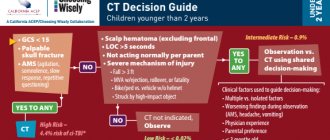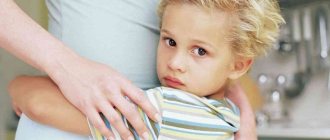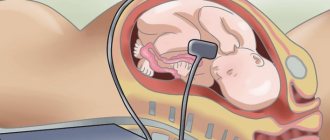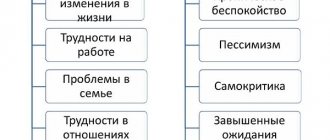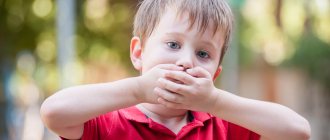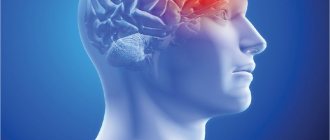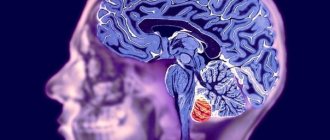Today we will talk about something that, unfortunately, often happens in children in the first year of life - traumatic brain injuries. For children, the most traumatic ages are considered to be 3 - 4 months, 1 - 1.5 years, 7 - 10 years. From 3 to 4 months, the baby masters turning over from his stomach to his back, his first independent change in body position in space. At the age of about 1 year, the baby learns to walk, but often loses its balance, hitting objects and falling. The age from 7 to 10 years marks the beginning of a child’s independent social life, when he goes to school, for a walk, etc., unaccompanied by adults.
As already mentioned, from 3 to 4 months the child masters turning over from back to stomach. Before starting to roll over, the baby trains, turns first on one side, then on the other, throws his leg, grunts, trying to turn over, and at some point turns over.
As a rule, such a metamorphosis is unexpected for adults caring for the baby, because they have managed to get used to the image of the child obediently lying on his back. This is where danger awaits us. As soon as the mother gets distracted for a second, takes a step to the side, the child falls. In 9 out of 10 cases, children fall from the changing pad, and since the heaviest part of the body is the head, the fall occurs head down.
According to statistics, in infancy, about 40% of children fall from a height, but, fortunately, nature took care of the babies and endowed them with a “margin of safety” in the form of an open fontanel, soft sutures between the bones of the skull, a large intracranial space, so only 1. 5% of falls from height have serious consequences. However, as practice shows, even if everything ended well, the horror of the experience and the feeling of guilt settle in the mother’s heart for a long time.
What to do if a child falls?
Try not to panic, take the child in your arms, calm him down, call an ambulance.
According to emergency care standards, every child with a head injury should be hospitalized. This usually happens like this: an ambulance delivers the baby and his mother to the emergency room of a specialized hospital, where the neurosurgeon on duty examines the child, conducts an ultrasound examination of the brain, and x-rays of the skull bones. If the baby’s condition does not cause concern and the examination reveals nothing wrong, the mother and child can be sent home under the supervision of a neurologist at their place of residence.
If, during examination, the baby cries continuously, or, conversely, is lethargic, or there is weakness in the arm or leg and the baby cannot move them, or there was repeated vomiting, or changes were detected during ultrasound examination and x-ray, then the child remains in the hospital and receives treatment according to the degree of traumatic brain injury.
Treatment uses medications that reduce swelling of the brain tissue, improve blood flow and metabolic processes in the nervous tissue.
An intracerebral hematoma can become a serious complication of traumatic brain injury, when blood from damaged vessels pours into the cranial cavity, which inevitably leads to compression of the brain. In such a situation, urgent surgery is required to remove the hematoma.
When the child’s condition becomes stable, he is discharged home under the supervision of a neurologist.
Types of soft tissue injuries in children
When considering traumatic injuries in children, it is necessary to mention that this issue is quite extensive and labor-intensive. It’s not for nothing that there is a separate science that studies these issues – traumatology. We will try to consider this topic from the pediatrics perspective.
In this regard, we will dwell in more detail on such damage as:
- Injury.
- Break.
- Shake.
These injuries, according to the classification, can be classified as closed soft tissue injuries.
Damage to soft tissues in children is a fairly common problem.
Below we will consider each type of damage, as well as its signs in the baby.
Shake
A concussion is understood as a mechanical effect on the body, which leads to functional changes in the organ without visible damage. When we talk about a concussion, we often mean a concussion.
Symptoms of a concussion:
- Headache.
- Dizziness.
- Nausea.
- Vomit.
- Double vision.
- Loss of consciousness and seizures may occur.
It is worth noting that a child’s head injury always requires consultation with a doctor and a number of instrumental examination methods.
Injury
A bruise is a mechanical injury that is not accompanied by a violation of the anatomical integrity. As a rule, the skin, subcutaneous fat, and muscle tissue are bruised. The cause of this damage is often a fall or impact with various objects.
Symptoms of a bruise in a baby:
- Pain. As a rule, pain occurs immediately. The degree of pain depends on the conditions of the injury and the force of the impact, the type of object or coating. A particularly painful area in children is the periosteum. Within one to two hours, the pain subsides, but may reappear if the hematoma grows.
- Swelling. Swelling forms almost instantly after injury. It is painful when pressed, and also does not have clear boundaries with healthy tissue. Usually the swelling increases within several hours; in rare cases, swelling may increase for up to one day.
- The appearance of a hematoma. A hematoma is a bleeding into soft tissue. The severity of the hematoma primarily depends on the type of damaged vessel and the force of the blow. Most often in children, small vessels rupture with blood soaking the skin and subcutaneous fat. Outwardly it looks like a “bruise”.
- Impaired function. This refers to the limitation of active movements, for example, of the limbs. This is due to an increase in swelling and pain due to injury.
Restriction of movement in case of injury is associated with swelling and pain due to injury.
Gap
A rupture, in contrast to a bruise, is a lesion of soft tissue in which there is a violation of the anatomical integrity.
Highlight:
- Ligament rupture.
- Tendons.
- Muscle
Ligament ruptures are accompanied by severe pain, swelling, and the appearance of a hematoma. Dysfunction of the affected joint is also characteristic. Muscle tears occur less frequently. Such damage usually develops with a large impact of gravity, a strong blow to the contracted muscles, or a rapid, strong contraction. A muscle tear has different symptoms, depending on the severity of the tear. As a rule, children experience incomplete ruptures. Children experience immediate severe pain, followed by the appearance of swelling and hematoma. The mechanism of formation of tendon rupture is similar to the mechanism of muscle rupture. When tendons rupture, children complain of pain, and a specific place of greatest pain is noted at the site of the rupture. The most characteristic symptom to distinguish from other injuries is loss of function of the muscle whose tendon is damaged.
Often injuries are accompanied by the appearance of wounds. You can find out more about this problem in our article.
What can be the consequences of injury?
In most cases, as already mentioned, infant falls end happily and do not affect the child’s development in any way. In 15% of cases, cerebrasthenic syndrome develops, when the child is often capricious, gets tired quickly, and does not gain weight and height well. This condition, without treatment, can last for several months and often causes developmental delays.
Such severe diseases as post-traumatic epilepsy, mental retardation, and cerebral palsy are formed as a result of brain injury in approximately 1.5% of cases. All patients with such a diagnosis are considered disabled; they require comprehensive rehabilitation treatment and supervision by specialists for many years, but even using the most modern treatment methods, it is not possible to completely get rid of the defect.
To avoid unpleasant consequences, do not lose your vigilance, especially if your child is approaching 3 months.
Bruises in children - should you see a doctor?
Usually, young children experience bruises on their elbows, knees, fingers and wrists - a child falls from his height and simply cannot get severely injured. In some cases, a small child does not have time to put his hands in front of him or turn on his side during a fall, so the nose, jaw and forehead are bruised, which, in principle, also does not pose a danger; you just need to use specific ointments for bruises and contusions in children. But if the baby fell, for example, from the steps, from a stool or from a stroller, and hit his head, then consultation with a traumatologist or, in extreme cases, with a pediatrician is definitely necessary.
Please note: if, after a fall from a height and a head injury, a child experiences dizziness, increased drowsiness, unusual crying (typical for very young children, up to the age of one and a half years), bleeding from the nose or ears, vomiting, or imbalance, then you should immediately seek help. qualified medical care. Moreover, such treatment is necessary even if only one of the listed symptoms is present.
I hasten to reassure parents: most often children suffer minor bruises; serious injuries are most likely the exception. Light bruises are accompanied by pain in the injured area, redness of the skin, swelling and swelling, and hematomas . The child may cry and complain of pain, but only immediately after the blow; soon this behavior disappears, and the baby’s general condition returns to normal.
Consequences of injury to the head and its occipital part
The consequences of injury to any head area are very serious. After all, the skull contains the brain - an important organ that “manages” everything that happens in the body. Therefore, if he is injured, there can be very serious consequences, namely:
- one-sided agnosia. This diagnosis implies a complete lack of perception of one side of the visual space. For example, if there is a bruise on the left side, a person ceases to perceive the left side;
- absent-minded attention, poor concentration, mild temper and irritability;
- disruption of normal sleep;
- memory impairment;
- weather dependence (when the weather changes, your health worsens);
- depression;
- frequent headaches, occasional dizziness;
- occasionally a person loses consciousness or his vision becomes dark;
- the appearance of hallucinations from time to time;
- frequent headaches;
- neck muscle spasm;
- blood pressure disturbance: when it rises, throbbing pain appears, and when pressure is low, morning dizziness is observed;
- poor performance.
The child hit his head: damage and wounds
What to do if a child hits his head and a bleeding wound appears:
In this case, you should give him the same help as for a bruise in any other place:
- On a bleeding wound, you should first apply ice (crushed ice or a bag of frozen vegetables is best), and a little later, make a pressure bandage;
- If the head wound is more than 7 mm wide and 2 cm long, the child must be taken to a medical facility - such wounds usually require stitches.
Let us repeat: if a child hits his head and a “bump” appears at the site of the injury, or even a small bleeding wound appears, but he does not lose consciousness, then no matter how “scary” it may look from the outside, it is a serious injury. there is no reason for the head. And if the baby does not show any dangerous symptoms (we will list them below), then you don’t even have to call a doctor or take your child to the hospital.
Treatment of head injuries
You should not try to carry out treatment on your own at home without the supervision of a specialist. For mild bruises, doctors recommend painkillers and bruise-resolving ointments. But only a specialist will be able to determine how severe the injury was caused by a fall and tell you what to do next. You shouldn’t leave everything to chance if a person hits the back of his head. If the victim is able to walk, he should be escorted to the nearest emergency room. In case of a more serious condition, first aid is needed, then you need to call the ambulance service. And remember! A bruise to the head and especially to the occipital part is a very serious injury. If this happens to a child, then this is fraught with consequences for his development. An adult can also have serious consequences, health problems and serious complications. To avoid unpleasant consequences, you should immediately contact specialists for medical help and timely treatment.
Babies under one year old
Babies most often roll onto the floor from changing tables, so you need to swaddle your baby not on the table, but, for example, on the sofa. He's shorter. Also, to cushion a possible fall, place a rug under a table or next to a sofa. Three more simple recommendations:
- do not take your eyes off the baby for a second while swaddling;
- try to hold it with your hand;
- If you need to go away (to get a bottle, or pick up the phone, or open the door), take the baby with you. Otherwise, he can turn over from his back to his stomach at any moment (it’s better not to think about the consequences of such an acrobatic sketch).
You have to keep an eye on the baby even when he lies quietly in his crib. However, lying down is half the battle. As soon as he starts to sit down, keep your eyes open. If your fidget has already mastered the art of sitting, urgently buy a low, stroller. And definitely mobile, that is, one in which the child can sit and lie down. It is more difficult for him to get out of such a stroller, and it is safer to fall.
The baby has grown up
Special socks with “brakes” (these are rubberized inserts in the sole of the sock that reduce slipping) can protect your child from falling in the apartment. They are especially useful in an apartment with parquet floors. Place rugs in places where your baby usually travels (but so that they lie tightly and do not slide on the floor). For the first time, wrap some thick material around the sharp corners of furniture and door jambs. Remove chairs and other furniture from the windows - this will keep an inquisitive little person from wanting to climb onto the windowsill or, scary to think, open the window.
Types of bruises
Depending on the location of the injury, there is the following classification of back bruises and their consequences:
- If the upper back , the cervical vertebrae may be affected. Sometimes this entails respiratory failure, paralysis, decreased muscle tone and paresis, and impaired sensitivity.
- A contusion to the mid-back can cause loss of coordination and sensation in the limbs. The victim may feel pain in the heart and experience discomfort while breathing.
- Injuries to the lower back can lead to problems with urination and decreased sensation in the legs.
The greatest danger comes from bruises affecting the spinal cord. The consequences of such an injury can be varied: from impaired circulation to rupture of nerve endings and paralysis.

